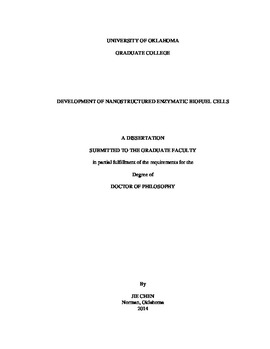| dc.description.abstract | Nanostructured enzymatic biofuel cells with high power density output and prolonged lifetime were developed by the incorporation of carbon nanotubes into redox polymer-enzyme films. The performance of the enzymatic biofuel cells was optimized by dispersing carbon nanotubes with different surfactants, modifying the method of nanotube incorporation, and varying the nanotube type and loading. The first part of this work focused on fabricating high surface area of single walled carbon nanotubes (SWNTs) for construction of redox polymer-enzyme based electrodes. It was demonstrated that the deposition of SWNTs(6,5) films onto glassy carbon electrodes from suspensions of the non-ionic surfactant Triton X-100 resulted in the highest response to glucose, producing current densities of ~1.7–2.1 mA/cm2. In contrast the formation of SWNTs networks from anionic surfactant suspensions (i.e. sodium cholate and NaDDBS) showed a decrease in the glucose response.
To demonstrate that these SWNTs networks could be applied to anodic films that contained enzymes other than glucose oxidase, we constructed redox polymer-enzyme films both with and without SWNTs but with the enzyme fructose dehydrogenase (FDH). We demonstrated that the electrochemical and enzymatic properties of FDH/redox polymer electrodes were highly dependent on both the pH of the enzyme solution and the redox polymer solution. The maximum current density of Fc-C6-LPEI/FDH electrodes was 245 µA/cm2. Modification of GCEs with SWNTs (6, 5) films prior to coating of the Fc-C6-LPEI/FDH films resulted in an increase in the fructose response to ~ 1 mA/cm2. Fabrication of enzymatic biofuel cells based on these films produced a power density of 29 µW/cm2 in response to fructose.
The role of SWNTs conductivity was investigated by comparing the performance of electrodes coated with SWNTs networks made from dispersions of conductive SWNTs(7,6) and semiconducting SWNTs(6,5). It was demonstrated that network of SWNTs(7,6) showed higher glucose response than networks of SWNTs(6,5) when coated with a mixture of the ferrocene redox polymer (FcMe2-C3-LPEI) and the enzyme (GOx). Optimizing the composition of SWNTs(7, 6) networks resulted in a maximum current density response to glucose of 11.2 mA/cm2. Furthermore, a novel method (mixing/ two layer method) was developed by incorporating carbon nanotubes into redox polymer-enzyme hydrogel films that were deposited onto the SWNTs networks. This mixing/two layer method resulted in a further increase in the response to glucose to 16.2 mA/cm2 at 37 oC. In addition, the stability of FcMe2-C3-LPEI / GOx electrodes increased with the incorporation of SWNTs. Applying the optimized SWNTs method to cathodes that were coated with a chloro-ferrocene redox polymer (Cl-Fc-LPEI) and the enzyme laccase generated biofuel cells that produced a maximum power density of 802 µW/cm2 at 355 mV and at 37 oC.
Finally, we evaluated the potential of high surface area vertically aligned multiwalled carbon nanotubes (MWCNTs) forests as an electrode platform. Coating of these MWCNTs platforms with a mixture of ferrocene redox polymer (FcMe2-C3-LPEI) and the enzyme glucose oxidase produced electrodes that were responsive to glucose despite the fact that a majority of the MWCNTs (>99%) were electrochemically inaccessible. | en_US |
